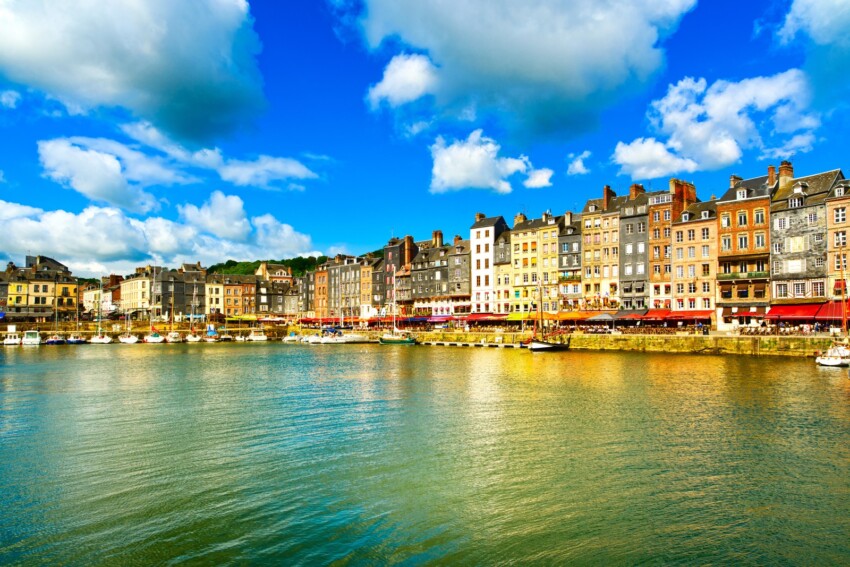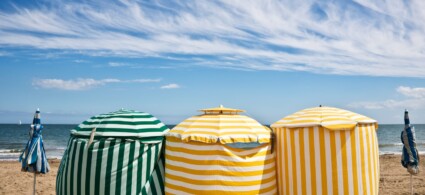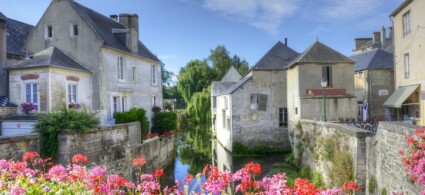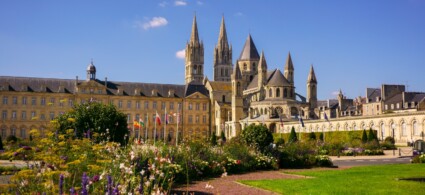

This part of Normandy is sadly known for one of the most tragic yet pivotal events of the 20th century, the landing of the Allies during World War II that took place right along the Calvados coast.
Many tourists choose Normandy precisely to visit the D-Day beaches and honour the fallen at the many memorial sites that dot this area. Here, you can experience the tragic nature of those events first-hand.
But the Calvados region is not only a theatre of sorrow: it is also and above all a land rich in traditions linked to the production of excellent cheeses such as the famous Camembert and of the Calvados apple distillate, the symbol liqueur of Normandy, of green and luminous countryside, of towns rich in history and art, of picture-postcard villages and of extremely hospitable people.
In particular, the Côte Fleurie (Côte Fleurie), the stretch of coastline stretching from Honfleur to Cabourg, is the most touristy and sought-after area, a succession of elegant seaside resorts that in summer is taken by storm by Parisians on holiday.
Low cliffs and long stretches of sand with dunes characterise this somewhat retro area with its period villas, striped umbrella-tents to shelter from the wind, elegant bistros and small towns full of boutiques and cafés.

On 6 June 1944, British, American and Canadian allied forces landed along the Calvados coast to liberate France from Nazi occupation. Omaha Beach, Utah Beach, Gold Beach, Juno Beach and Sword Beach are the landing beaches that have become infamous for one of the bloodiest battles in modern history.
It was one of the most tragic and dramatic pages of modern history: huge human losses occurred on both sides. In Arromanches and in the villages of the Cote de Nacre, you can visit the places of memory, the museums that tell the story of the D-Day operations through films, original objects and assault vehicles. Battlefields, bombing craters, defence lines and military cemeteries tell the story in the most vivid way imaginable.

Honfleur is a charming seaside village on the south bank of the Seine estuary. This enchanting town gives its visitors picture-postcard images, thanks to its picturesque harbour framed by beautiful narrow houses with delicate pastel colours and black slate roofs.
All this is embellished by the ships moored at the quays, the busy restaurants and the numerous historic quarters that retain its old-world charm.

The two most famous towns on the Cote Fleurie are a haven for Parisians in search of good sea air, windy beaches and fine seafood.
Deauville and Trouville are almost twin towns, separated only by a bridge. They have retained a quaint, belle époque retro charm with 19th century mansions, colourful parasols and art deco beach cabins dotting the long seaside promenade.

Bayeux is an old town, which miraculously escaped the bombings of World War II, famous for its small, perfectly preserved centre, its large Gothic cathedral but above all for its incredible medieval tapestry.
At 68 metres long, the tapestry recounts, in great detail, the Norman invasion of England: a kind of picture book, a masterpiece of craftsmanship and skill that tells the story through the interwoven threads.

The historic town of Caen suffered extensive damage from World War II bombings.
Fortunately, thanks to considerable restoration and redevelopment work, it is still possible to admire the castle, a small portion of the medieval quarter and the two imposing Gothic abbeys, the Abbaye des Hommes and the Abbaye des Dames, which were spared the devastation.

Houlgate is a town that has retained all the retro charm of the belle epoque by escaping the alterations of the building boom. The beach is really pretty, framed by period houses and the former Grand Hotel that resembles a castle with its large round tower.
Houlgate has more than 200 old villas, built between 1860 and 1914, a harmonious succession of different styles, from English cottages to Gothic manor houses, from Rococo chateaux to Swiss chalets to palaces inspired by the medieval and Moorish periods: it is worth taking a tour to see them from the outside, as far as the Moulin Landry, an old renovated paddle mill.
Unfortunately, the beach at Dives-sur-mer has silted up over the centuries and the town has receded a good two kilometres from the sea. Today, it is connected to the coast by the course of the Dives River and retains a pretty little river port.
The church of Notre-Dame is worth a visit for its beautiful stained-glass windows and nave. Note the lepers’ hole, a corner for the sick to attend religious services.
Don’t miss a visit to the covered market (Tuesday mornings and Saturdays), original from the 14th century, impressive for the size of its roofing, a true work of art of carpentry: it still has old wooden stalls and signs depicting pigs, horses and roosters.
Just a stone’s throw from the market is the village of Guillame le Conquérant, a beautiful complex of old medieval buildings decorated with stone and wood carvings in which they have created small shops, restaurants and art galleries.
Cabourg, a stately town, is a quieter and more peaceful version of neighbouring Douville, so dear to Proust as to be described under the false name of Balbec in In the Shadow of the Maidens in Bloom.
And you can still breathe in that slightly decadent atmosphere so beloved of the writer while sipping tea or going to the casino.
This important scallop-fishing port enjoys a beautiful natural setting, nestled between two high cliffs covered in greenery. Here, too, the battle for invasion was fierce and it was only liberated on the evening of 7 June after fierce fighting.
A path from behind the tower allows you to skirt the cliffs while admiring the beautiful landscape. At the end of the harbour, early in the morning you can admire the spectacle of the arrival of the boats with the day’s catch for the daily auctions.
On 15 August, the blessing of the sea is celebrated: since 1908, the town has been decorated with colourful nets and boats decorated with thousands of paper roses commemorate the souls of those lost at sea.
The image of John Steele, an American parachutist who got his parachute caught in the bell tower of the church of Sainte-Mère-Église during a jump on the night of 6 June 1944 has gone around the world and become a symbol not only of D-Day but also of the town.
The story is recounted in the film The Longest Day and now a dummy hangs from the church roof. If you want to learn about the stages of the landing and the role this town played in history (it was the first French commune to be liberated), you can visit the Musée Airborne.

Nestled in beautiful countryside is this beautiful Renaissance château located in the town of Mortrée, the Château d’O, which owes its name to the family that built it in the late 15th century.
For its beauty, reflected in the waters of the moat, it can easily compete with the neighbouring and more famous Loire châteaux: the delicacy of the courtyard decoration, the complexity of the roofs, the character of the slender towers, the optical effect of the combination of brick and stone highlight the elegance and charm of this castle.
The Château de Vendeuvre was built in 1750 by Alexandre le Forestier as a summer residence and is still occupied by the same family: it is the perfect representation of a manor dedicated to leisure and the pleasures of nature.
The owners have managed to preserve its original décor and furniture, which can be seen in the estate’s orangery.
There are also several beautiful gardens not to be missed, from the water garden, a path between two labyrinths with water features in all its forms including islands, waterfalls, streams, surrounded by centuries-old trees coexisting with a young arboretum to the French garden, from the grotto of the Nymphs to the exotic garden.
This massive castle is certainly the oldest in Normandy. Within its thick and squat walls, William the Conqueror was born and its origins date back to the 9th century: in fact, there are several stratifications until it was built in 1123.
A visit to the castle will take you back in time, to stories of knights, sieges and fortifications. From the Talbot tower you can admire an exceptional panorama of the valley below where La Fontaine d’Arlette is located: legend has it that it was here that King Robert met Arlette, the tanner’s daughter who would soon become his bride.
This elegant residence has retained its charm and authenticity, combining the robustness of a medieval fortress, the charm of the Renaissance and the distinction of the classical period.
This fortress is one of the most fascinating châteaux in Normandy. A visit to it is simply astonishing, passing through the immense green park in which it is immersed, admiring the simple materials that give it an effect of great refinement, walls of pink briques and light granite, grey-blue slate roofs reflecting in the water of the moats and a truly unique magnificence.
Built in the 10th century on the banks of the Sarthe, the city of Beaumont-sur-Sarthe is located on the axis linking Alençon to Le Mans, on the Loire border.
Within an elliptical shape, the small town boasts a castle-fortress dating back to the 11th century: it overlooks the terrace with its many gardens. Before leaving this small village, take a walk along the charming riverside promenade.

The town of Lisieux was completely rebuilt after 13 bombings in June 1944. The town is famous for being a place of pilgrimage for devotees of St. Therese, who died here.
The beautiful Cathédrale Saint-Pierre is the main attraction in Lisieux: a splendid Gothic church is surrounded by a beautiful garden, the Jardin de l’Eveché, designed by the creator of the gardens of Versailles. Much less interesting, however, is the pharaonic St Theresa’s Basilica, built in 1928 and inspired by the Romanesque and Byzantine styles.
Although almost two-thirds of the town was demolished by bombing in 1944, the village of Pont l’Évêque has been completely rebuilt, bringing to new splendour half-timbered houses, picturesque alleyways and the old urban layout that winds partly along the canals, among flower-covered houses.
A true corner of peace and tranquillity that has preserved all the charm of the Calvados lands. In fact, in addition to the centre, the town is surrounded by beautiful meadows and gardens overlooking the canal, bucolic views of pure poetry that would surely have enchanted the Impressionists.
Don’t miss the 15th-century Église Saint-Michel, with its splendid naves bathed in light, and the magnificent convent converted into the Espace Culturel les Dominicaines.
Finally, don’t miss the Cheese Festival on the second weekend in May.
Founded in 1120 by Henry I Beauclerc, son of William the Conqueror, the town has preserved traces of its past as a fortress charged with defending the border of Normandy.
The medieval city, bounded by the belt of its aligned moats, preserves the remains of its walls: it was originally made up of three fortified towns, separated by inner walls and irrigated by canals that allowed its economic development and shaped its landscape.
Fortunately spared from the fury of World War II, the city has a rich and varied architectural heritage. Surrounding the Place de la Madeleine, a large welcoming space in the heart of the centre, is the traditional Saturday morning market, which takes place along streets lined with half-timbered houses, some of which are decorated with magnificent carved ornaments.
The town is a continuous alternation of houses from the late Middle Ages and mansions from the old regime, alongside numerous Romanesque, Gothic and Renaissance churches.
Saint-Ceneri-le-Gerei is a village built on a rocky spur overlooking the Sarthe River near Alençon and is considered one of the most beautiful villages in France. It was founded in 1044 by William Giroie, who also built a castle of which only the walls remain today.
Visit the village church from where you can enjoy splendid views over the valley and inside you can admire sculptures and frescoes. Take a walk along the river where you will find the chapel of St. Ash, and reach, on the right bank, the cave considered to be a miraculous spring that appeared to the monk to quench his thirst.
Don’t miss the Mansonière gardens, a stone’s throw from here: explore its nine walled gardens forming a green microcosm. It is also possible to make nocturnal visits to the candle-lit gardens on Saturdays in summer until the end of September.
The beautiful medieval town of Domfront was founded in the 11th century. Soon stone buildings replaced wood and a defence system was built with an imposing main tower and 24 towers connected by a network of ramparts.
Today, the remains of the donjon and walls recall the power of the medieval town, which has always been the envy of kings and lords. Indeed, it was here that the court of Henry II the Plantagenet settled, who brought luxury and entertainment to the austerity of its walls.
Today, you can admire a particularly charming historical centre with its original urban grid, half-timbered houses, walls and small flower-filled squares: it is a real hidden gem because very few tourists come here!
In the heart of Calvados lies this village, the beating heart of the area’s agricultural life. In fact, every Monday in Saint-Pierre-sur-Dives there is a lively market in the Halles, the old 13th-century market destroyed by bombing in 1944 and entirely rebuilt using the 290,000 wooden pegs saved from the fire. Here you can admire and taste the best of the area’s rural produce.
The Benedictine Abbey founded in 1012 on the spot where Saint Wambert was killed by the Vikings was active until the Revolution: today only the church is in use while the other buildings in the complex have been converted into shops and offices.
The Château de Vendeuvre, on the other hand, is set in an idyllic rural landscape just 5 km from the village. Nobles lived here before the Revolution, surrounded by luxury (the wooden bed made for Louis XV’s daughter’s cat is on display) and a beautiful estate with gardens, fountains and a shell grotto.
At the centre of Normandy, Argentan is a city of culture, heir to a rich past, and has preserved over the centuries remarkable monuments, many ancient mansions that are the jewels of its architectural heritage.
Crossed by the Orne River and surrounded by forests, the city of Argentan offers a pleasant urban environment to visit, still on a human scale. Heir to a rich past, the city has preserved over the centuries exceptional monuments such as the Tour Marguerite, the Donjon, the Chapelle St Nicolas, the Château, the St germain and St Martin churches.
In addition, Argentan has preserved one of the jewels of its cultural heritage: lace-making. The Benedictine nuns of the Benedictine Abbey of Notre Dame continue the delicate art of lace-making while preserving its secret.
Lying on the river Vée and the shores of the lake, Bagnoles de l’Orne is a beautiful spa town, surrounded by the lush Forêt des Andaines.
Everything here is reminiscent of the ancient splendour of a wealthy belle époque town: marvellous old villas, manor houses and castles overlook the waters, making it a delightful place to relax or enjoy the activities on offer in the area, such as cycling trails, tennis courts and golf courses, climbing gyms and many shows during the summer season.
Don’t miss the town hall, housed in a wonderful fairy-tale castle, although the real attraction of the town are the spas where you can enjoy a day of wellness and relaxation.
If, on the other hand, you love adventure, you can go into the forest to admire the ruins of a manor house nestled in the woods.
Victor Hugo fell under the spell of this small town in 1836 and you can still understand why, when you stroll along the river to enjoy the view of the castle or walk through the maze of streets housing the most representative houses with decorations of bagpipers, griffins and wolves.
Around the central square of Lassay-les-Châteaux, beautiful houses with carved lintels open up. Follow the small streets to reach the beautifully preserved 15th-century castle fortress. While in the meadow of the old Benedictine convent, a splendid rose garden, a veritable archive of old roses, history and the art of gardening.
This small town of ancient vestiges boasts a magnificent cathedral, a splendid and majestic monument from the 13th and 14th centuries. Built on unstable ground, it had to be reinforced over the centuries with huge buttresses that gradually expanded and enriched its structure. It is absolutely one of the best examples of Gothic architecture in Normandy.
At its foot, the old quarters are formed by a labyrinth of streets and alleyways, ideal for bucolic walks among old houses and palaces. It is also an opportunity to discover local handicrafts.
Don’t miss in summer the Musilumières, a sound and light show inside and outside the cathedral.
Alençon is a city steeped in medieval history, with ancient cobbled streets, shops, chocolate shops, beautiful parks and markets (Thursdays and Saturdays) that are well worth a visit.
The church of Notre-Dame is a splendid example of flamboyant Gothic architecture to be admired especially in its stained glass windows. If you love lace then you must go to the Museum of Fine Art and Lace to learn all its intricate techniques.
The old Chateau des Ducs is truly imposing: its lugubrious reputation was born when it became the headquarters of the Gestapo during World War II.
For the best of Norman cuisine, head to Au Petit Vatel where you can sample Camambert’s stuffed pancakes or chicken à la crème Normande.
This lively town in the Suisse Normande will amaze you with its narrow alleyways, granite houses with colourful wooden shutters: perched atop a hill, it dominates the Orne valley.
Take a regenerating stroll along the leafy riverbank dotted with guinguettes, or cafés with a terrace on the water.
If you enjoy water activities, you can kayak or canoe along the river, while if you want to admire the valley, you can climb to Pan de Sucre, which can be reached via several paths and admire the landscape.
Cheese lovers should not miss the opportunity to visit two temples of French cheese.
In the home of the famous cheese Camembert28, the only attractions are the Maison du Camembert and the Fromagerie Durand, where you can discover all the secrets of cheese-making.
Although not as famous as its cousin Camembert, Livarot29 enjoys great prestige on French soil. Don’t miss a visit to Le Village Fromager with a tasting at a local dairy.
In the following map you can see the location of the main places of interest mentioned in this article.



